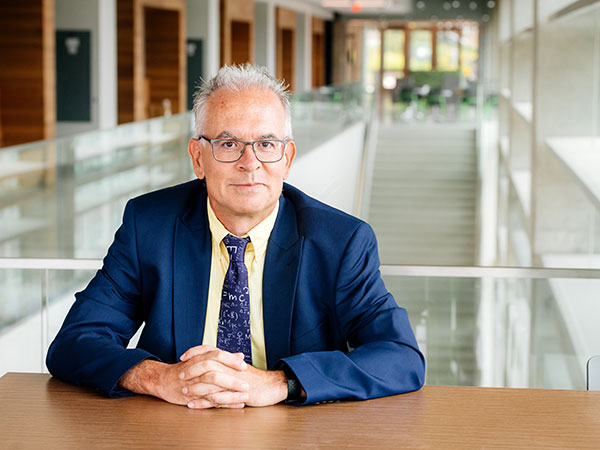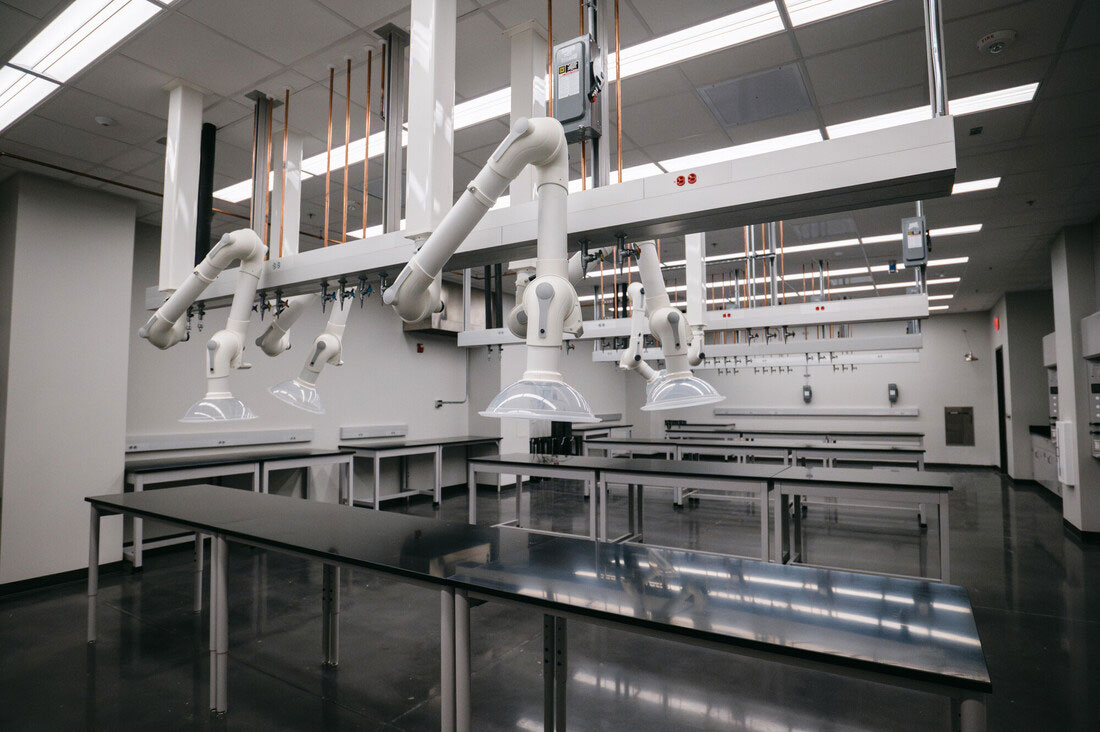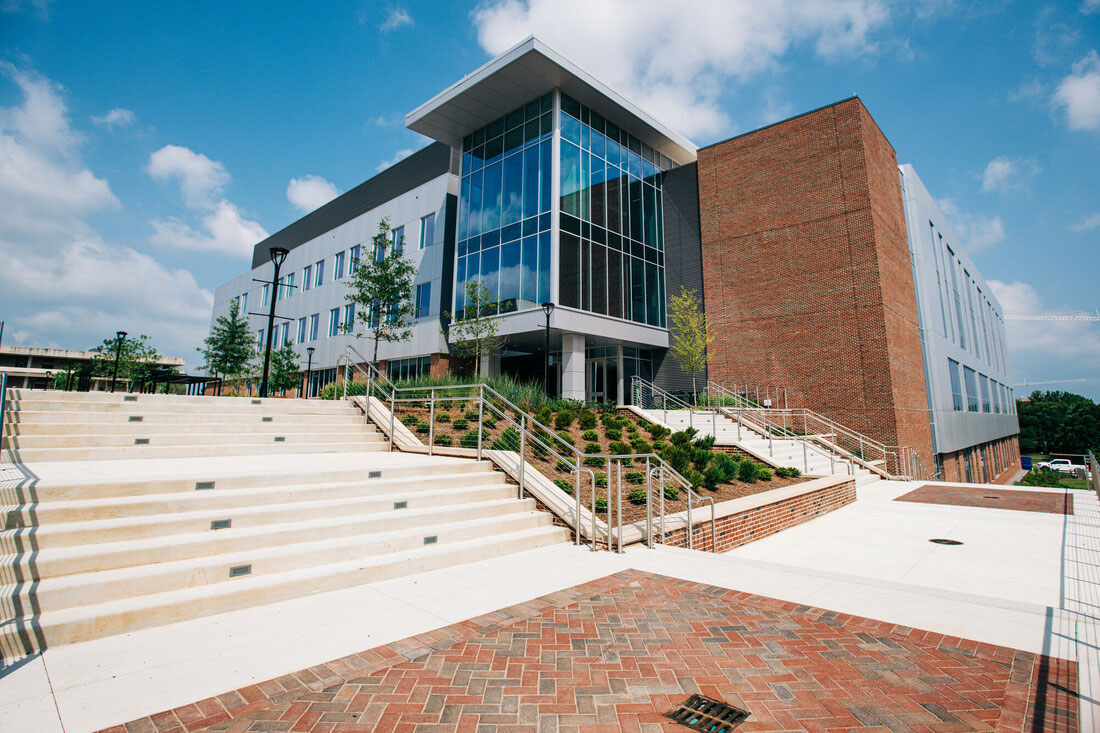 For University of Alabama at Birmingham Department of Physics chair Ilias Perakis, Ph.D., the new UAB Science and Engineering Complex ideally illustrates one of his favorite quotes.
For University of Alabama at Birmingham Department of Physics chair Ilias Perakis, Ph.D., the new UAB Science and Engineering Complex ideally illustrates one of his favorite quotes.
“Why are we constrained by the past,” Perakis said with a smile, “when the opportunities for the future are boundless?”
Indeed, it can be challenging to educate and train students for the 21st-century workforce out of a 20th-century building. Perakis said that is especially true in the field of physics with its emphasis on ``Emerging Technologies and Society,” including such areas as artificial intelligence and quantum materials.
“The physics department of today is not the same as the physics department of yesterday,” Perakis said. “Its entire nature has changed. The department is now preparing students of all backgrounds and levels of preparation for the fourth industrial revolution through advanced materials, advanced computation, and advanced photonics.”
“The state of Alabama has identified those three sectors as major areas for economic development. Materials tie in with manufacturing and defense, computation with machine learning and artificial intelligence, and photonics are a major part of all the new technologies. All three are also vital components of the frontiers of medicine. This new building has areas that will allow us to advance each of these.”
Perakis said that many of the changes brought by the new facility are structural. For example, not only will the building have state-of-the-art lasers with various frequencies and purposes, but something as simple as enhancing the air flow will improve the function and durability of the equipment.
“To use a laser for research, you have to control the dust with filters that improve the air quality. You have to control the air temperature. Everything must be extremely stable,” Perakis said. “All of this is furthered by the new building. These resources support sophisticated equipment that functions optimally because it’s operating under the right conditions.”
Perakis also is excited about the open layout of the new facility, with offices, labs, and research areas that will help promote a more collaborative work environment and better connect students with research.
“By having open blocks of space dedicated to broad research areas, you can develop synergies, rather than having the separation of individual labs for individual staff,” Perakis said. “This will revitalize culture in the department and facilitate student collaboration, since all students will be exposed to everybody else. This is a way to push interdisciplinary research projects and develop the well-educated workforce demanded by the 21st-century economy and create high-paying jobs.
 Interior of new Science and Engineering Complex showing a laboratory on the bottom floor equipped with exhaust snorkel dome hoods at each station.“The building helps in developing this kind of culture, approach, and environment. That’s why it’s important. It’s a way to address very practical issues and attract students to UAB by providing them a high-quality experience that is hard to find elsewhere.”
Interior of new Science and Engineering Complex showing a laboratory on the bottom floor equipped with exhaust snorkel dome hoods at each station.“The building helps in developing this kind of culture, approach, and environment. That’s why it’s important. It’s a way to address very practical issues and attract students to UAB by providing them a high-quality experience that is hard to find elsewhere.”
Department of Physics associate professor Cheng-Chien Chen, Ph.D., agreed. He said he is quick to promote the new building whenever he talks with prospective students about coming to UAB.
“It will help us attract strong students,” Chen said. “I showed just the outside of the building to a student who was thinking about coming to UAB to work with me, and the student was very impressed.
“That’s the message we need to convey to people, that UAB is strong and willing to invest in fundamental science. It will give a very positive image that will help us attract strong students and new faculty. So we’re excited about the new building and the impact it will bring.”
Adam Smith, a current UAB Department of Physics Ph.D. student, is one of those people who was impressed by the new facility even before he ever stepped inside. A native of Illinois who received an undergraduate degree in physics from the University of Missouri, Smith has been at UAB since 2020 conducting research on applying machine learning to the discovery of new superconducting materials.
“The main thing that we can already see happening is the new building gives us more opportunities to show just how good our physics department is,” Smith said. “I think we’ll be able to get more grants, which will allow us to get more instrumentation. We can really make a name for ourselves in the field of physics by having this new facility and the opportunities that come along with it.”
Perakis said one of the opportunities he wants to explore is bringing in outside companies and non-profit organizations to work with UAB physics students on various projects.
“Efforts in this direction are already underway through the Magic City Data Collective, which trains students in data, computation, and technology through project-based learning,” said Perakis. “Collaboration with the K-12 community and workforce development programs will allow us to make a direct impact on creating a diverse pipeline to science, technology, engineering, mathematics, and medicine (STEMM) careers. The new facility will enable the Department of Physics to increase such interaction and expand these collaborations, thus bringing new opportunities to UAB students.
 From sidewalk, exterior of Phase I of the new Science and Engineering Complex and Sterne Plaza.“The building is a tool that we can use in distinct ways,” Perakis said. “We want companies to come in and connect with our students and their work. The students can display their work, and the companies can meet these students. You can’t do that without the proper environment, which the new building now provides. It can also work as a facility where companies come for research and development that they can’t do by themselves. This facility is going to raise the quality of the product that we offer as a university.”
From sidewalk, exterior of Phase I of the new Science and Engineering Complex and Sterne Plaza.“The building is a tool that we can use in distinct ways,” Perakis said. “We want companies to come in and connect with our students and their work. The students can display their work, and the companies can meet these students. You can’t do that without the proper environment, which the new building now provides. It can also work as a facility where companies come for research and development that they can’t do by themselves. This facility is going to raise the quality of the product that we offer as a university.”
In turn, Perakis said, the impact will be felt far beyond the UAB Department of Physics. He points out that research breakthroughs in physics can directly affect work being done within the health sector, particularly in the field of precision medicine, which he expects to expand significantly in the coming years.
“How do you prepare the infrastructure so that, when new things become possible, you are ready to capitalize on them? That’s what this new building will do,” Perakis said. “It’s going to help us create an impeccable integration between education, research, workforce development, and community outreach. It will make our experiential learning accessible to more and more students, beyond the traditional disciplines.”
As an example of the far-reaching educational capabilities offered by the new space, the new physics facilities include a visionary “Maker Space” that will promote data fluency and digitally enhanced additive manufacturing initiatives. This space is designed to be a workspace for a broad population of students with all levels of preparation to hone their knowledge and skills in advanced manufacturing, data analytics, digital design, and computational modeling through immersive hands-on learning experiences. Taken all together, the new building will be much more than just a physical space for the Department of Physics.
“I envision that the new Science and Engineering Complex will foster convergent research in physics, materials science, computer science, and engineering,” Chen said. “It will do this by facilitating and promoting interdisciplinary activities among faculty members, postdocs, and a diverse community of graduate and undergraduate students.”
And in the process, create a future where, as Perakis says, “the opportunities are boundless.”


